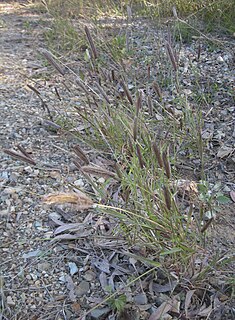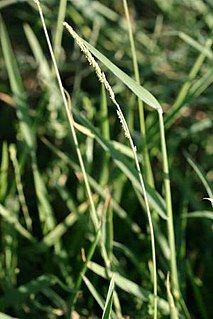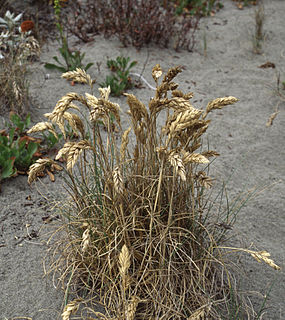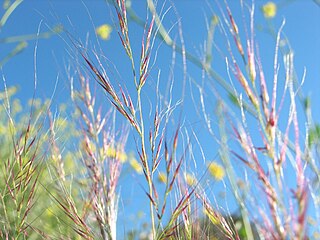
Danthonia californica is a species of grass known by the common name California oatgrass. This plant is native to two separate regions of the Americas, western North America from California to Saskatchewan, and Chile.

Elymus glaucus is a species of grass known as blue wild rye or blue wildrye. This grass is native to North America from Alaska to New York to northern Mexico. It is a common and widespread species of wild rye.

Bothriochloa barbinodis is a species of grass known by the common name cane bluestem. It is native to the Americas, including most of South and Central America, Mexico, and the southernmost continental United States from California to Florida.

Bromus vulgaris is a species of brome grass known by the common name Columbia brome.

Chloris virgata is a species of grass known by the common names feather fingergrassfeathery Rhodes-grass and feather windmillgrass.

Cynosurus echinatus is a species of grass known by the common names bristly dogstail grass, rough dog's-tail and hedgehog dogtail. It is native to southern Europe, and it is known in the Americas and Australia as an introduced species and sometimes a noxious weed. An herbicide-resistant strain can be found growing as a weed in canola and wheat fields in Chile. This is an annual grass growing 10 to 50 centimeters tall. The inflorescence is a rounded or oval cluster or series of clusters of spikelets. The fertile spikelet has an awn up to a centimeter long. The awns clumped closely together into a tuft gives the inflorescence its bristly, hairy appearance.

Eriochloa contracta is a species of grass known by the common name prairie cupgrass. It is native to the central United States and it is naturalized in areas to the east and west, where it is often a weed, especially in moist areas. This annual grass may grow up to a meter tall when erect or it may bend, rooting where nodes on the stem touch the ground. The inflorescence is up to 20 centimeters long and is made up of several branches which stick out to the sides. The branches are lined with purplish spikelets a few millimeters long.

Melica aristata is a species of grass known by the common names awned melic and bearded melicgrass.

Muhlenbergia microsperma is a species of grass known by the common name littleseed muhly. It is native to the Americas from the Southwestern United States and California through Central America into Peru and Venezuela.

Paspalum urvillei is a species of grass known by the common name Vasey's grass, or Vaseygrass. It is native to South America, and it is known in parts of North America as an introduced species. It is also naturalised in Australia, New Zealand, Japan, China, and southern Africa, including Madagascar. It is a noxious weed where it has been introduced in Hawaii and New Caledonia. It grows well in disturbed habitat, often in moist areas. This is a rhizomatous perennial grass which may reach 2 meters tall. The leaves are up to 2.5 centimeters wide and have a large, noticeable ligule. The inflorescence is a spreading or drooping array of up to 20 branches lined with rounded spikelets.

Melinis repens is a species of grass known by the common names rose Natal grass, Natal red top, or simply Natal grass. It is native to southern Africa and an introduced species, often considered a noxious weed, on other continents such as North America and Australia. It is an annual or perennial grass, growing up to a meter tall. Its growth rate is dependent on temperature. The inflorescence is an open array of branches bearing spikelets densely coated in silky white or pink hairs.
Pleuropogon refractus is a species of grass known by the common name nodding semaphoregrass. It is native to the west coast of North America from British Columbia to northern California, where it grows in moist meadows, marshy areas, and shady forests.

Poa bigelovii is a species of grass known by the common name Bigelow's bluegrass. It is native to the southwestern United States and northwestern Mexico, where it grows in shady spots in desert and plateau habitat.

Poa leptocoma is a species of grass known by the common names marsh bluegrass and western bog bluegrass.

Poa macrantha is a species of grass known by the common names seashore bluegrass and large-flowered sand dune bluegrass. It is native to the west coast of North America from Alaska to northern California, where it grows in sand dunes and other beach habitat.

Poa napensis is a rare species of grass known by the common name Napa bluegrass. It is endemic to Napa County, California, where it is known from only two occurrences near Calistoga. It grows in moist, mineral-rich soil around hot springs. The rare grass only occurs on private, unprotected land and depends on water from the hot springs; changes to the local water regime or any other aspects of its specific habitat type would affect the plant. This grass was federally listed as an endangered species in 1997, along with another rare local hot spring endemic, the Calistoga popcornflower.

Poa unilateralis is a species of grass known by the common names San Francisco bluegrass, ocean-bluff bluegrass, and sea-bluff bluegrass.

Setaria verticillata is a species of grass known by the common names hooked bristlegrass, rough bristle-grass and bristly foxtail. It is native to Europe, but it is known on most continents as an introduced species and often a noxious weed. It is a hardy bunchgrass which grows in many types of urban, cultivated, and disturbed habitat. It is a weed of many types of agricultural crops, growing in vineyards and fields. Herbicide-resistant strains have been noted.

Spartina gracilis is a species of grass known by the common name alkali cordgrass.

Vulpia microstachys is a species of grass known by the common names small fescue and small sixweeks grass. It is native to western North America from British Columbia to Colorado and New Mexico to Baja California, where it grows in many types of open habitat, including grasslands. It is dominant on some grasslands of California, and it was probably an abundant native grass before the habitat was altered by invasive non-native grasses. It occurs on serpentine soils with associates such as serpentine reedgrass. It is also known from parts of South America. It is an annual grass producing one stem or a clump of several stems growing up to 75 centimeters tall. The inflorescence has several open branches bearing clusters of purple-tinged spikelets. The spikelet has one to six flowers. The grass is usually cleistogamous, its flowers fertilizing themselves.




















